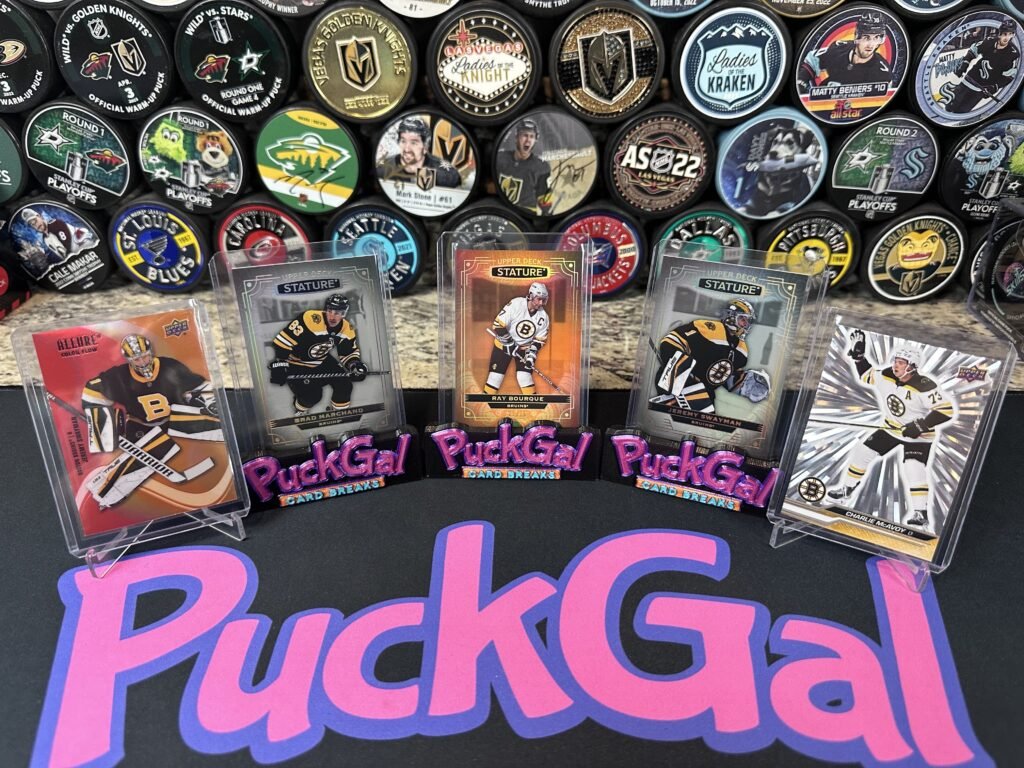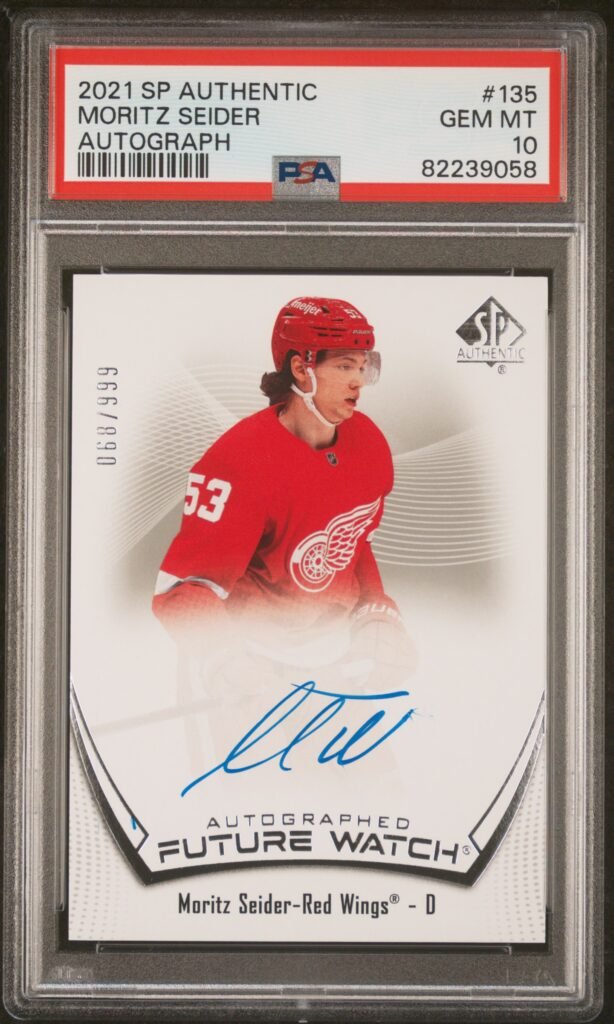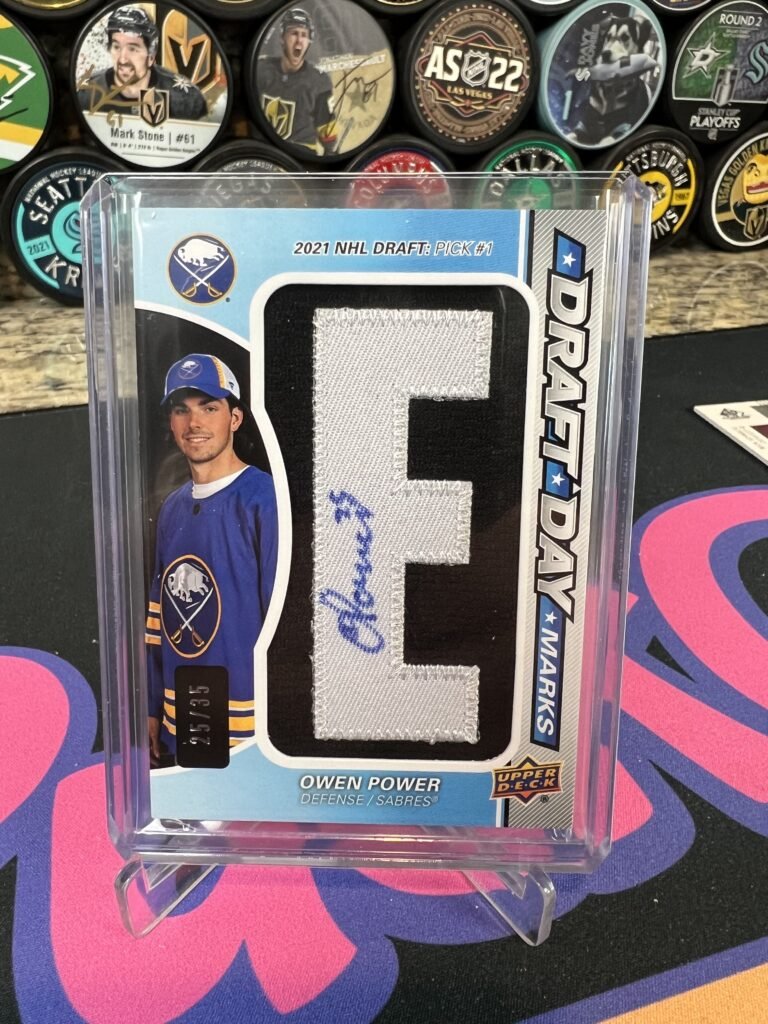Hockey card collecting is a popular hobby enjoyed by both novices and experienced collectors. Many people are drawn to the hobby because of their love for the sport and the excitement of collecting and trading hockey cards. Whether you’re just starting out or looking to expand your collection, this beginner’s guide will provide you with all the information you need to get started in the world of hockey card collecting.
Beginner’s Guide to Hockey Cards – The 5 Basics
- Collecting hockey cards can bring immense joy and allow you to connect with your favorite players and teams.
- Set goals for your collection, learn about different card types and sets, and develop a strategy for acquiring new cards.
- Familiarize yourself with the basics of hockey card collecting, including the types of cards available and card brands.
- Consider building a valuable collection by acquiring cards with high demand and potential for future value appreciation.
- Understand the grading process to determine the condition and quality of a card.
The Joy of Collecting Hockey Cards
Collecting hockey cards is so much more than just a hobby. It’s a passion that brings immense joy to collectors of all ages. When you hold a hockey card in your hands, you’re not just holding a piece of cardboard with a player’s picture on it. You’re holding a connection to your favorite players and teams, reliving memorable moments in the sport, and building a personal collection that reflects your love for the game.
As a beginner, it’s important to approach hockey card collecting with a sense of excitement and curiosity. Set goals for your collection, whether it’s to obtain cards of your favorite players, complete a specific set, or acquire rare and valuable cards. Have a strategy in place for acquiring new cards, whether it’s through buying packs, trading with other collectors, or attending card shows.
“Collecting hockey cards allows me to stay connected to the sport that I love. It brings back memories of watching games with family and friends and creates new memories as I build my collection. There’s a sense of joy and fulfillment that comes with each new card I add to my collection.” – Melissa M., Moderator, Ladies Of The Bruins
One of the great joys of hockey card collecting is the thrill of the hunt. It’s the excitement of opening a pack of cards and discovering what treasures lie within. It’s the satisfaction of finding that one card you’ve been searching for, the one that completes your set or features your favorite player. It’s the joy of sharing your collection with other enthusiasts and engaging in the community of hockey card collectors.
Tips for Maximizing Your Hockey Card Collecting Experience
To make the most of your hockey card collecting journey, here are a few tips to keep in mind:
- Research and learn about different card types and sets to expand your knowledge and make informed collecting decisions.
- Connect with other collectors through online forums, social media groups, or local card shows to share insights, trade cards, and learn from experienced collectors.
- Organize and protect your cards using card sleeves, binders, and storage boxes to preserve their condition and maintain their value.
- Stay up to date with the latest trends and news in the hobby, such as new card releases, player signings, and industry updates.
By following these tips and embracing the joy of collecting, you’ll embark on a rewarding journey in the world of hockey card collecting, where each card becomes a treasured piece of the sport’s history and a source of endless joy.
Getting Started with Hockey Card Collecting
As a newbie to the world of hockey card collecting, it’s essential to lay a strong foundation by understanding the basics. This will pave the way for an enjoyable and rewarding experience in this popular hobby. So, let’s kick things off by exploring how to get started with hockey card collecting.
First and foremost, familiarize yourself with the different types of hockey cards available. This includes base cards, which feature players in their regular poses or game action shots. Rookie cards are another type to look out for. These cards capture a player’s first year in the league and can hold significant value in the future. Autograph cards, as the name suggests, are signed by the players themselves, making them highly sought after by collectors.
Once you understand the card types, it’s time to delve into the world of card brands and sets. Each brand offers unique features and designs, so take some time to research and find the ones that resonate with you. Some popular brands include Upper Deck, Panini, and Topps. Additionally, familiarize yourself with the various sets released by these brands, such as Upper Deck Series 1 and Series 2.
Remember, knowledge is power in the world of hockey card collecting. Take the time to educate yourself about the different card types, brands, and sets. This will help you make informed decisions when buying cards and building your collection.
When starting your collection, it’s crucial to have a buying guide. Look for reputable sources, such as hobby shops, online retailers, and card shows. These venues offer a wide selection of cards to choose from, allowing you to find the perfect additions to your collection. Ensure you prioritize purchasing packs or boxes from trusted sources to avoid counterfeit cards.
As you dive deeper into the hobby, remember that collecting hockey cards is a journey. Enjoy the process of searching for valuable cards, organizing your collection, and connecting with fellow collectors. By starting on the right foot and continually expanding your knowledge, your hockey card collection will grow into a pride and joy that reflects your passion for the sport.


Building a Valuable Hockey Card Collection
As you continue your journey of collecting hockey cards, you may be interested in building a valuable collection that will not only bring you joy but also have the potential for future value appreciation. To achieve this, it’s important to identify and acquire cards that hold a high demand and are considered valuable in the market.
One type of card that collectors often prioritize is the rookie card of popular players. These cards mark the beginning of a player’s career and can significantly increase in value as they achieve success on the ice. Additionally, limited edition sets, such as those with low print runs or special designs, can also be highly sought after by collectors.
“Collecting valuable hockey cards involves identifying and acquiring cards that have high demand and potential for future value appreciation.”
Another category of valuable hockey cards includes those that feature rare memorabilia or autographs. These cards often have a premium price due to their uniqueness and the connection they provide to a player or a specific moment in the sport’s history. Keep an eye out for cards that showcase game-worn jersey pieces, patches, or even signed items.
Discovering Hockey Card Collecting Resources
Building a valuable hockey card collection requires research and access to resources that can help you stay updated with market trends and find the cards you desire. The internet is a valuable tool for collectors, as it offers various platforms where you can buy, sell, and trade cards. Online marketplaces, forums, and social media groups dedicated to hockey card collecting can provide valuable insights and connections within the community.
Additionally, consider joining local card shows and events, where you can meet fellow collectors, discover new cards, and learn from experienced enthusiasts. These gatherings often feature vendors who specialize in hockey cards and can offer valuable advice on building a valuable collection.
By incorporating these strategies and utilizing available resources, you can enhance your chances of building a valuable hockey card collection that brings you both personal satisfaction and potential financial gains in the future.
Understanding Hockey Card Grading
Hockey card grading is a critical aspect of the hobby, as it determines the condition and quality of a card. Graded cards are assigned a numerical grade, usually on a scale of 1 to 10, by professional grading companies. The grading process takes into account factors such as the card’s centering, corners, edges, and surface condition.
Graded cards hold a higher value in the market because they provide collectors with assurance regarding the authenticity and condition of the card. High-grade cards are especially coveted by collectors, as they are more likely to appreciate in value over time.
“The grading system helps collectors assess the condition of a card without physically inspecting it. It provides a standardized way of evaluating cards and helps determine their market value,” explains John Smith, a veteran hockey card collector.


The Importance of Graded Cards
In the competitive world of hockey card collecting, graded cards offer several advantages. Firstly, they provide peace of mind to collectors who want to ensure the authenticity and condition of their cards. Secondly, graded cards often command higher prices compared to ungraded cards, making them a valuable asset for collectors and investors alike.
The demand for graded cards has surged in recent years, with many collectors focusing on building collections that exclusively feature graded cards. This trend is driven by the desire for quality and the perceived long-term value of high-grade cards.
Understanding Grading Labels
Graded cards come with labels that provide important information about the card’s condition. These labels typically include the card’s numerical grade, the company that graded it, and any additional designations or qualifiers. For example, a card may have a “Gem Mint 10” grade, indicating the highest possible grade for the card’s condition.
It’s important for collectors to familiarize themselves with the grading labels used by different companies and understand what each label signifies. This knowledge will help collectors make informed decisions when buying or selling graded cards.
Overall, understanding hockey card grading is essential for collectors looking to assess the value and condition of their cards. Graded cards not only offer peace of mind but also hold higher value in the market, making them a valuable addition to any hockey card collection.
Popular Hockey Card Sets
When it comes to hockey card collecting, there are several popular card sets that have captured the attention of collectors. These sets offer a variety of cards, including base cards, autographs, and even memorabilia cards, making them highly sought after by enthusiasts. If you’re a beginner looking to start your hockey card collection, here are some of the best hockey card brands and sets to consider:
Upper Deck Series 1 and Series 2: These sets are a staple in the hockey card collecting community. They feature a comprehensive selection of base cards, as well as sought-after Young Guns rookie cards that highlight the top rookies of the season. The Series 1 set is typically released in November, while Series 2 follows in February, allowing collectors to stay up to date with the latest roster updates.
Panini Contenders: This set is known for its autograph cards, which are highly prized by collectors. Panini Contenders includes cards featuring on-card autographs from top NHL players, making them a valuable addition to any collection. The set also features rookie autographs, making it a great choice for those interested in collecting rookie cards.
Topps Chrome: Known for its sleek and shiny design, Topps Chrome offers a unique and visually appealing option for collectors. The set includes a variety of special parallel cards and refractors, which give the cards a distinct shine. Topps Chrome is particularly popular among collectors who appreciate the aesthetic appeal of their cards.
These are just a few examples of the popular hockey card sets available. Each set has its own unique features and appeal, so it’s a good idea to explore different brands and sets to find the ones that align with your collecting preferences. Whether you’re interested in base cards, autographs, or memorabilia cards, there’s a hockey card set out there that will capture your attention and become a valuable addition to your collection.


Rookie Hockey Cards and Their Value
When it comes to hockey card collecting, rookie cards hold a special place in the hearts of collectors. These cards capture a player’s first year in the league and often become highly sought after as the player’s career progresses. The value of rookie cards can fluctuate over time, making them an exciting addition to any collection.
As a beginner, it’s important to understand the factors that contribute to the value of rookie hockey cards. A player’s performance on the ice, their popularity among fans, and their potential for future success all play a role in determining card value. Additionally, the scarcity of a rookie card and its condition can greatly impact its worth.
“Rookie cards are the foundation of any great hockey card collection. They represent the beginning of a player’s journey and often become the most sought after cards in the market.” – PuckBoy, Moderator, PuckGal Card Breaks
Notable rookies such as Wayne Gretzky, Mario Lemieux, and Sidney Crosby have seen their rookie cards reach astronomical values over the years. These cards are considered iconic pieces of hockey history and are highly coveted by collectors.
Understanding the Potential
It’s important to note that the value of rookie hockey cards can change over time. As a player’s career progresses and they achieve milestones or championships, the demand for their rookie card may increase. Conversely, if a player’s performance declines or they experience off-ice issues, the value of their rookie card may decrease. Keeping an eye on player performance and market trends can help collectors make informed decisions about buying, selling, or holding onto their rookie cards.
Whether you’re a casual collector or an avid investor, rookie hockey cards offer a thrilling opportunity to own a piece of hockey history. The value and significance of these cards make them an essential part of any hockey card collection. So keep your eye out for those promising rookies and watch their cards soar in value as their careers take off.
Vintage Hockey Cards
When it comes to hockey card collecting, vintage cards hold a special place in the hearts of enthusiasts. These cards, produced in earlier years, are considered classics in the hobby and are highly sought after by collectors. Vintage hockey cards not only provide a glimpse into the history of the sport but also carry a higher value due to their rarity and collectability.
As a beginner, it’s important to have knowledge of vintage cards and understand their unique qualities. There are different brands and sets available, each with its own distinct features and appeal. From the iconic Topps and O-Pee-Chee sets to the legendary Parkhurst cards, vintage hockey cards offer a wide variety of options for collectors to explore.
“Vintage hockey cards are like treasures from the past, capturing the essence of the game’s greatest moments and players. They are a testament to the rich history of hockey and hold immense value for collectors who appreciate the nostalgia and authenticity they represent.”
To ensure you’re investing in authentic vintage cards, it’s essential to educate yourself about the characteristics and markings that indicate their legitimacy. Understanding the different printing techniques, card designs, and variations can help you spot counterfeit or altered cards. Additionally, consulting reputable resources and experts in the hockey card collecting community can provide valuable insights and guidance when it comes to vintage card authentication.
Preserving the Legacy
Vintage hockey cards are not only valuable collectibles but also pieces of sporting history. They offer a glimpse into the players, teams, and moments that have shaped the game of hockey. Preserving the legacy of these cards is crucial to ensure their longevity and continued appreciation in the hobby.
Proper storage and handling techniques are essential to prevent damage or deterioration to vintage cards. Utilizing protective sleeves, binders, or storage boxes specifically designed for trading cards can help protect them from exposure to light, moisture, and other elements that could degrade their condition.
By understanding the significance of vintage hockey cards and taking the necessary steps to preserve and appreciate them, collectors can truly embrace the rich heritage and timeless beauty of these treasured pieces of the hobby.
A Beginner’s Guide to Hockey Card Trading
Trading hockey cards is an exciting part of the hobby that allows collectors to connect with fellow enthusiasts and expand their collections. Whether you’re trading with friends, attending card shows, or participating in online forums, there are valuable tips and strategies to keep in mind for successful trading.
Firstly, it’s important to assess the value of the cards you’re looking to trade. Research the current market trends and use reputable price guides to determine the approximate value of the cards involved. This will help ensure that you are making fair and balanced trades.
When negotiating a trade, communication is key. Clearly express your interests and what you are looking for in return. Be open to compromises and consider the preferences of the other party. Remember, trading should be a mutually beneficial experience.
Protecting yourself from fraudulent transactions
Never send your cards or make a trade without receiving the other party’s cards first. It’s essential to establish trust and verify the legitimacy of the cards before completing the transaction. If trading online, use secure platforms with reputable sellers to minimize the risk of fraud.
Lastly, document your trades and keep a record of the cards involved. This can help you track your collection’s value, identify any missing cards, and provide proof of ownership in case of disputes.
By following these tips and guidelines, you can navigate the world of hockey card trading with confidence and ensure a positive and rewarding experience as you continue to expand your collection.
Conclusion
Congratulations! You’ve reached the end of this beginner’s guide to hockey card collecting. Hopefully, this guide has provided you with valuable insights and information to help you embark on your hockey card collecting journey.
Remember to have fun, set goals, and continue learning about the hobby as you build your collection. Whether you’re a casual collector or an avid investor, the world of hockey card collecting offers endless opportunities for enjoyment and discovery.
So, what are you waiting for? Start exploring the world of hockey card collecting today and see where it takes you. Happy collecting!
FAQ
What are the different types of hockey cards?
There are various types of hockey cards, including base cards, rookie cards, autograph cards, and memorabilia cards.
How can I determine the value of a hockey card?
The value of a hockey card is influenced by factors such as rarity, condition, player popularity, and demand in the market. You can consult price guides, online marketplaces, and professional appraisers to get an idea of a card’s value.
What are some valuable hockey cards to look for?
Valuable hockey cards include rookie cards of popular players, limited edition sets, and cards featuring rare memorabilia or autographs.
How does hockey card grading work?
Hockey card grading involves professional grading companies assessing the condition and quality of a card. Graded cards are assigned a numerical grade, usually on a scale of 1 to 10, based on factors like centering, corners, edges, and surface.
What are some popular hockey card sets?
Popular hockey card sets include Upper Deck Series 1 and Series 2, Panini Contenders, and Topps Chrome. Each set offers a variety of cards, including base cards, autographs, and memorabilia cards.
What makes rookie hockey cards valuable?
Rookie hockey cards are highly sought after because they feature a player’s first year in the league. The value of these cards can increase over time if the player has a successful career.
How can I identify authentic vintage hockey cards?
To identify authentic vintage hockey cards, it’s important to familiarize yourself with the different brands and sets produced in earlier years. Researching card designs, printing methods, and using reputable sources can help you spot authentic cards.
What are some tips for successful hockey card trading?
When trading hockey cards, assess the value of cards, negotiate fair trades, and protect yourself from fraudulent transactions. Consider attending card shows, joining online trading forums, or trading cards with friends to diversify your collection.

